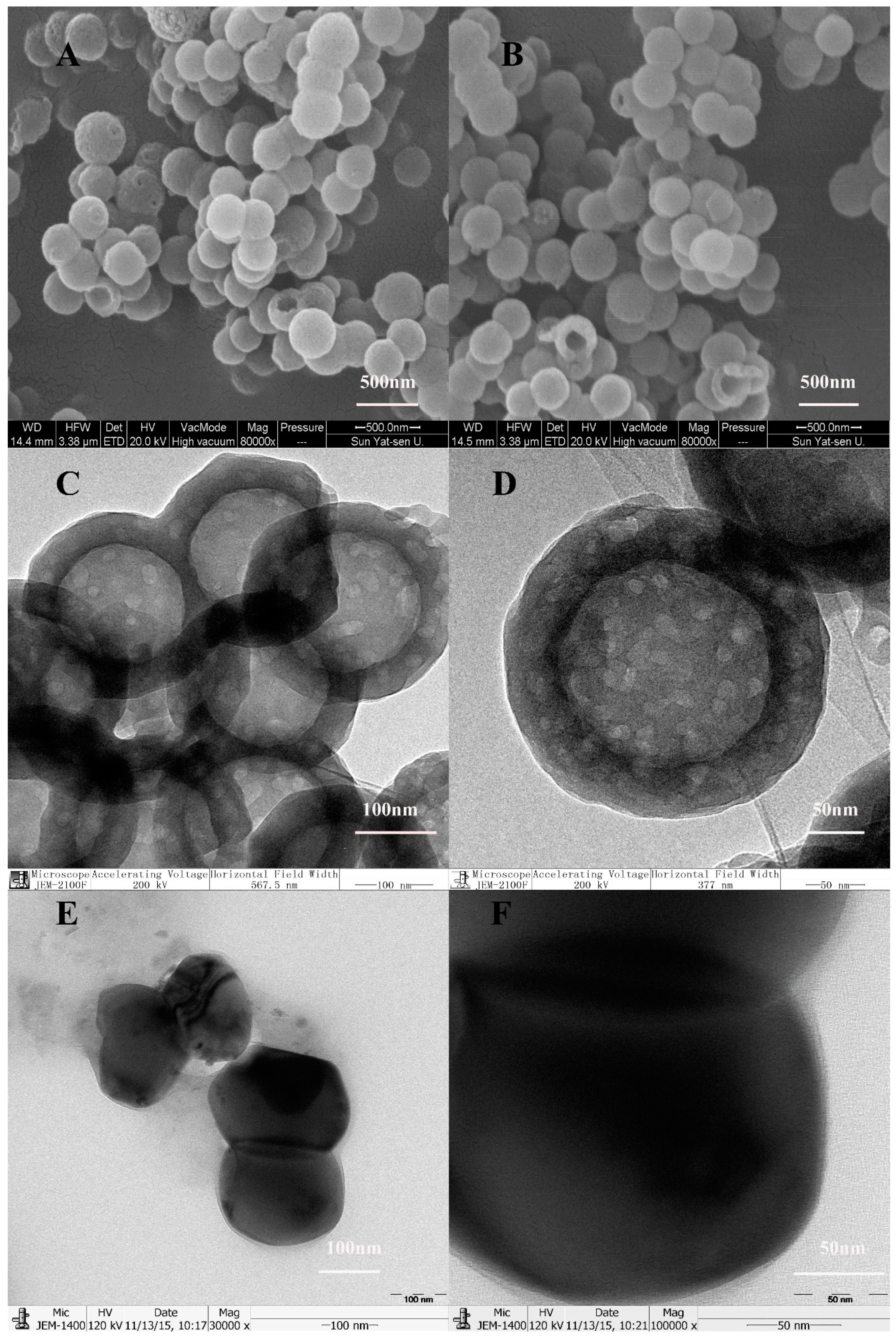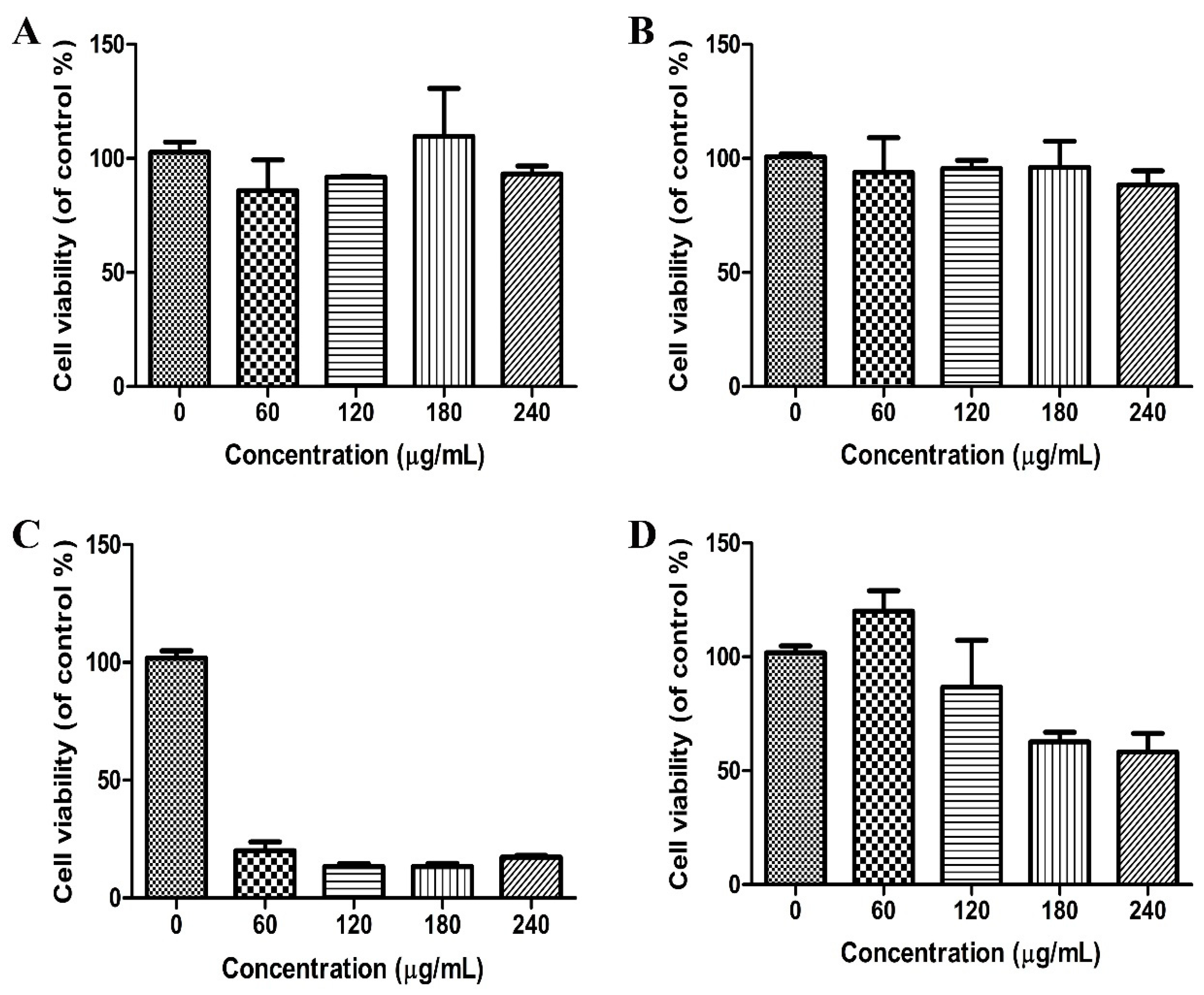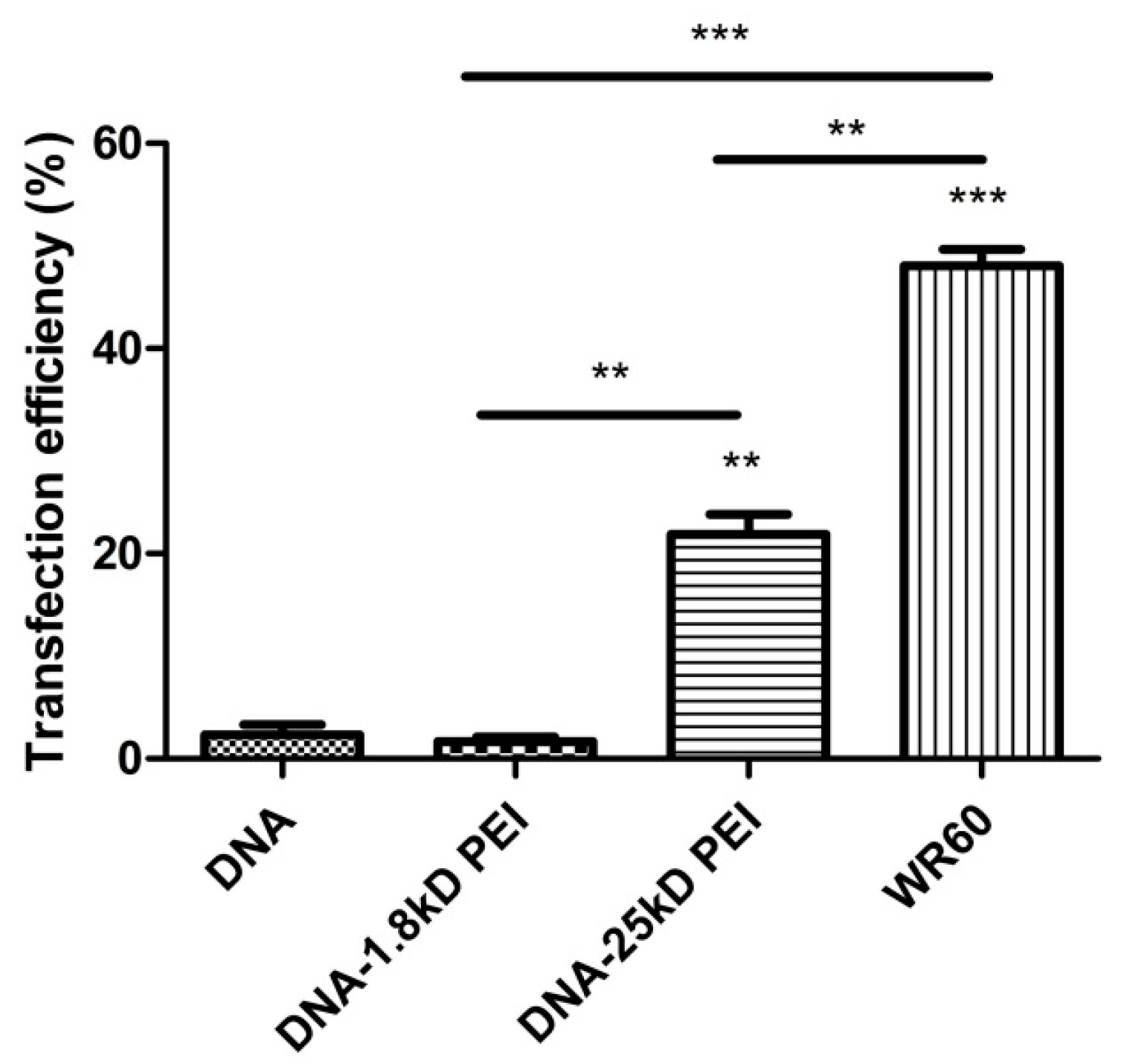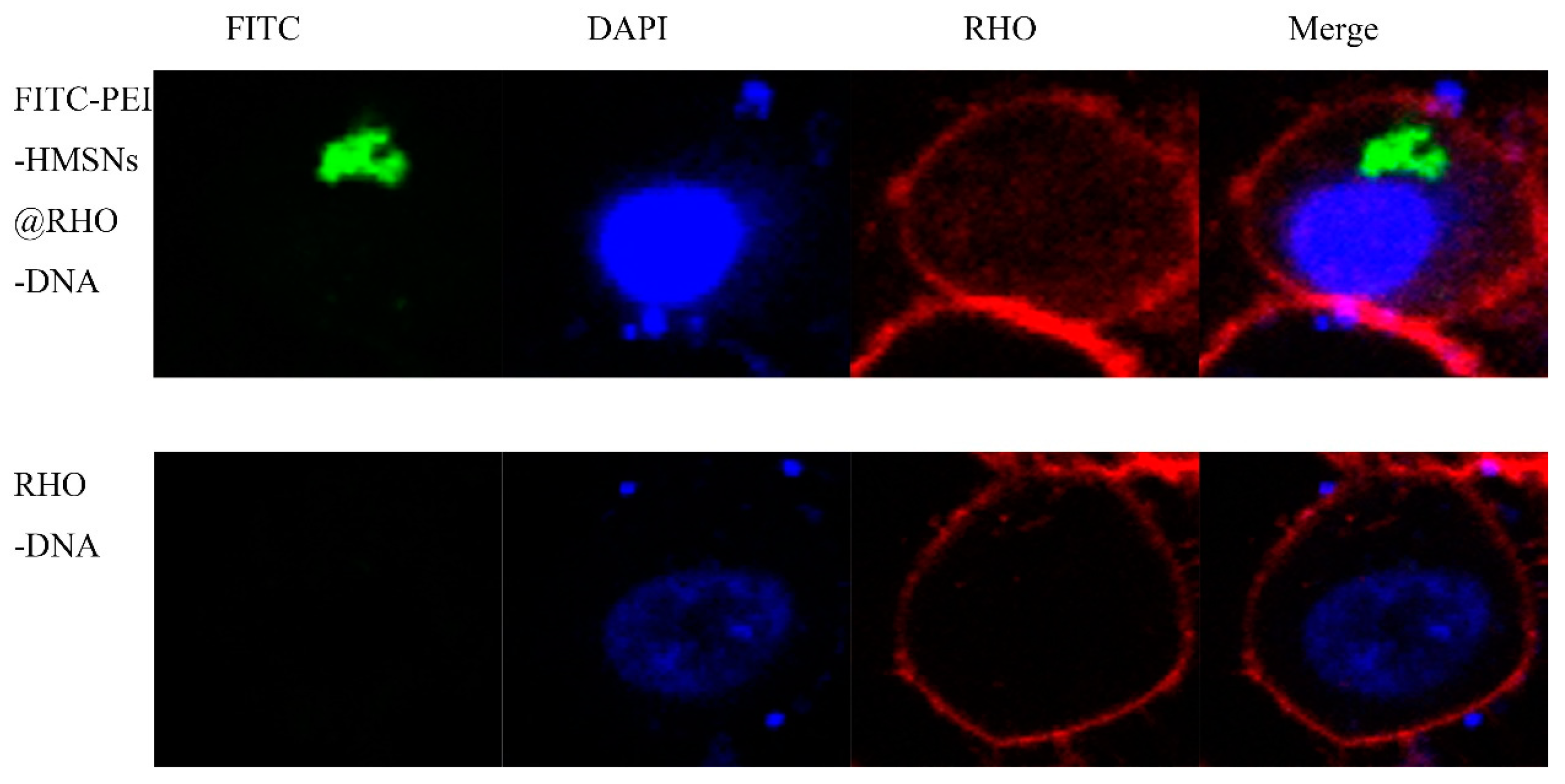Improved Gene Transfer with Functionalized Hollow Mesoporous Silica Nanoparticles of Reduced Cytotoxicity
Abstract
:1. Introduction
2. Results and Discussion
2.1. Synthesis and Characterization of HMSNs
2.2. DNA Adsorption Ability of PEI-HMSNs
2.3. Cytotoxicity of PEI-HMSNs
2.4. Gene Transfer Efficiency and Cellular Uptake
3. Materials and Methods
3.1. Materials
3.2. Methods
3.2.1. Synthesis of Large Pore-Sized HMSNs
3.2.2. Characterization of HMSNs
3.2.3. Synthesis of GFP Labelled DNA, i.e., GFP-DNA
3.2.4. Preparation of PEI-HMSNs
3.2.5. Preparation of FITC-PEI-HMSNs
3.2.6. Preparation of DNA-PEI-HMSNs
3.2.7. DNA Loading Efficiency Test
3.2.8. Cytotoxicity Study
3.2.9. In Vitro Transfection Experiments
3.2.10. Confocal Microscopy Study
4. Conclusions
Acknowledgments
Author Contributions
Conflicts of Interest
References
- Mandrup, O.A.; Lykkemark, S.; Kristensen, P. Targeting of phage particles towards endothelial cells by antibodies selected through a multi-parameter selection strategy. Sci. Rep. 2017, 7, 42230. [Google Scholar] [CrossRef] [PubMed]
- Zhang, J.Y.; Guo, S.P.; Zhang, W.F.; Niu, D.C.; Gong, J.P. Large-pore mesoporous silica nanospheres as vehicles for delivering TRAF3-shRNA plasmids to kupffer cells. Biochem. Biophys. Res. Commun. 2016, 469, 196–202. [Google Scholar] [CrossRef] [PubMed]
- Uno, S.; Masai, H. Efficient expression and purification of human replication fork-stabilizing factor, claspin, from mammalian cells: DNA-binding activity and novel protein interactions. Genes Cells 2011, 16, 842–856. [Google Scholar] [CrossRef] [PubMed]
- Brevet, D.; Hocine, O.; Delalande, A.; Raehm, L.; Charnay, C.; Midoux, P.; Durand, J.O.; Pichon, C. Improved gene transfer with histidine-functionalized mesoporous silica nanoparticles. Int. J. Pharm. 2014, 471, 197–205. [Google Scholar] [CrossRef] [PubMed]
- Thomas, T.J.; Tajmir-Riahi, H.A.; Thomas, T. Polyamine-DNA interactions and development of gene delivery vehicles. Amino Acids 2016, 48, 2423–2431. [Google Scholar] [CrossRef] [PubMed]
- Kircheis, R.; Wightman, L.; Wagner, E. Design and gene delivery activity of modified polyethylenimines. Adv. Drug Deliv. Rev. 2001, 53, 341–358. [Google Scholar] [CrossRef]
- Greenwald, R.B.; Choe, Y.H.; McGuire, J.; Conover, C.D. Effective drug delivery by pegylated drug conjugates. Adv. Drug Deliv. Rev. 2003, 55, 217–250. [Google Scholar] [CrossRef]
- Yamada, T.; Iwasaki, Y.; Tada, H.; Iwabuki, H.; Chuah, M.K.; VandenDriessche, T.; Fukuda, H.; Kondo, A.; Ueda, M.; Seno, M.; et al. Nanoparticles for the delivery of genes and drugs to human hepatocytes. Nat. Biotechnol. 2003, 21, 885–890. [Google Scholar] [CrossRef] [PubMed]
- Choy, J.H.; Kwak, S.Y.; Jeong, Y.J.; Park, J.S. Inorganic layered double hydroxides as nonviral vectors. Angew. Chem. 2000, 39, 4041–4045. [Google Scholar] [CrossRef]
- Aznar, E.; Oroval, M.; Pascual, L.; Murguia, J.R.; Martinez-Manez, R.; Sancenon, F. Gated materials for on-command release of guest molecules. Chem. Rev. 2016, 116, 561–718. [Google Scholar] [CrossRef] [PubMed]
- Chen, Y.P.; Chen, C.T.; Hung, Y.; Chou, C.M.; Liu, T.P.; Liang, M.R.; Chen, C.T.; Mou, C.Y. A new strategy for intracellular delivery of enzyme using mesoporous silica nanoparticles: Superoxide dismutase. J. Am. Chem. Soc. 2013, 135, 1516–1523. [Google Scholar] [CrossRef] [PubMed]
- He, X.X.; Wang, K.M.; Tan, W.H.; Liu, B.; Lin, X.; He, C.M.; Li, D.; Huang, S.S.; Li, J. Bioconjugated nanoparticles for DNA protection from cleavage. J. Am. Chem. Soc. 2003, 125, 7168–7169. [Google Scholar] [CrossRef] [PubMed]
- Kneuer, C.; Sameti, M.; Bakowsky, U.; Schiestel, T.; Schirra, H.; Schmidt, H.; Lehr, C.M. A nonviral DNA delivery system based on surface modified silica-nanoparticles can efficiently transfect cells in vitro. Biocon. Chem. 2000, 11, 926–932. [Google Scholar] [CrossRef]
- Hung, B.Y.; Kuthati, Y.; Kankala, R.K.; Kankala, S.; Deng, J.P.; Liu, C.L.; Lee, C.H. Utilization of enzyme-immobilized mesoporous silica nanocontainers (IBN-4) in prodrug-activated cancer theranostics. Nanomater. Basel 2015, 5, 2169–2191. [Google Scholar] [CrossRef] [PubMed]
- Kankala, R.K.; Kuthati, Y.; Liu, C.L.; Mou, C.Y.; Lee, C.H. Killing cancer cells by delivering a nanoreactor for inhibition of catalase and catalytically enhancing intracellular levels of ros. Rsc. Adv. 2015, 5, 86072–86081. [Google Scholar] [CrossRef]
- Xia, T.A.; Kovochich, M.; Liong, M.; Meng, H.; Kabehie, S.; George, S.; Zink, J.I.; Nel, A.E. Polyethyleneimine coating enhances the cellular uptake of mesoporous silica nanoparticles and allows safe delivery of siRNA and DNA constructs. ACS Nano 2009, 3, 3273–3286. [Google Scholar] [CrossRef] [PubMed]
- Zhang, L.; Qiao, S.Z.; Jin, Y.G.; Chen, Z.G.; Gu, H.C.; Lu, G.Q. Magnetic hollow spheres of periodic mesoporous organosilica and Fe3O4 nanocrystals: Fabrication and structure control. Adv. Mater. 2008, 20, 805–809. [Google Scholar] [CrossRef]
- Chen, Y.; Chen, H.R.; Guo, L.M.; He, Q.J.; Chen, F.; Zhou, J.; Feng, J.W.; Shi, J.L. Hollow/rattle-type mesoporous nanostructures by a structural difference-based selective etching strategy. ACS Nano 2010, 4, 529–539. [Google Scholar] [CrossRef] [PubMed]
- Chen, Y.; Chu, C.; Zhou, Y.; Ru, Y.; Chen, H.; Chen, F.; He, Q.; Zhang, Y.; Zhang, L.; Shi, J. Reversible pore-structure evolution in hollow silica nanocapsules: Large pores for sirna delivery and nanoparticle collecting. Small 2011, 7, 2935–2944. [Google Scholar] [CrossRef] [PubMed]
- Hom, C.; Lu, J.; Liong, M.; Luo, H.; Li, Z.; Zink, J.I.; Tamanoi, F. Mesoporous silica nanoparticles facilitate delivery of sirna to shutdown signaling pathways in mammalian cells. Small 2010, 6, 1185–1190. [Google Scholar] [CrossRef] [PubMed]
- Solberg, S.M.; Landry, C.C. Adsorption of DNA into mesoporous silica. J. Phys. Chem. B 2006, 110, 15261–15268. [Google Scholar] [CrossRef] [PubMed]
- Florea, B.I.; Meaney, C.; Junginger, H.E.; Borchard, G. Transfection efficiency and toxicity of polyethylenimine in differentiated Calu-3 and nondifferentiated COS-1 cell cultures. AAPS PharmSci. 2002, 4, 1–11. [Google Scholar] [CrossRef] [PubMed]
- Quan, G.L.; Pan, X.; Wang, Z.H.; Wu, Q.L.; Li, G.; Dian, L.H.; Chen, B.; Wu, C.B. Lactosaminated mesoporous silica nanoparticles for asialoglycoprotein receptor targeted anticancer drug delivery. J. Nanobiotechnol. 2015, 13, 7. [Google Scholar] [CrossRef] [PubMed]






© 2017 by the authors. Licensee MDPI, Basel, Switzerland. This article is an open access article distributed under the terms and conditions of the Creative Commons Attribution (CC BY) license (http://creativecommons.org/licenses/by/4.0/).
Share and Cite
Zhan, Z.; Zhang, X.; Huang, J.; Huang, Y.; Huang, Z.; Pan, X.; Quan, G.; Liu, H.; Wang, L.; Wu, A.C. Improved Gene Transfer with Functionalized Hollow Mesoporous Silica Nanoparticles of Reduced Cytotoxicity. Materials 2017, 10, 731. https://doi.org/10.3390/ma10070731
Zhan Z, Zhang X, Huang J, Huang Y, Huang Z, Pan X, Quan G, Liu H, Wang L, Wu AC. Improved Gene Transfer with Functionalized Hollow Mesoporous Silica Nanoparticles of Reduced Cytotoxicity. Materials. 2017; 10(7):731. https://doi.org/10.3390/ma10070731
Chicago/Turabian StyleZhan, Zhengwen, Xiaoxu Zhang, Jiayuan Huang, Ying Huang, Zhengwei Huang, Xin Pan, Guilan Quan, Hu Liu, Lili Wang, and And Chuanbin Wu. 2017. "Improved Gene Transfer with Functionalized Hollow Mesoporous Silica Nanoparticles of Reduced Cytotoxicity" Materials 10, no. 7: 731. https://doi.org/10.3390/ma10070731




